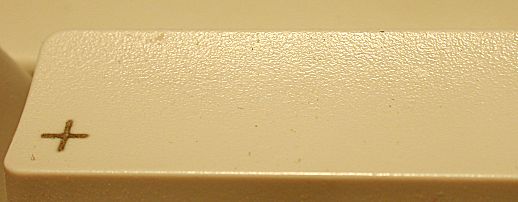[ The PC Guide | Systems and Components Reference Guide | Keyboards | Keyboard Construction and Operation | Keycaps ]
Keycap Shape and Texturing
If you asked someone to recall from memory what the keycaps on a keyboard look like, they would probably say that are somewhat cube-shaped. (Actually, they'd probably say you were nuts for caring, and that they'd never really thought about it before you asked your silly question. But I often get that reaction, and that's a different matter entirely. :^) ) If you actually look at your keyboard you'll see that the keys are not really cubic at all; they are more like truncated pyramids, if anything, but of a rather unique shape. Their shape is designed to maximize comfort during extended typing.
As mentioned in the section on keycap size, the keycaps are tapered, increasing in size as you go from the top to the bottom. The tapering is usually asymmetrical, with a more shallow taper at the front of each key, and a steep tapering at the back of the keycap. This design helps "catch" the fingers as they strike the keycaps; the asymmetry is likely designed to match the slight forward pressure that is part of the keypress motion.
Keycaps also have a distinct curvature, which refers to the shape of the top surface of each key. The keycaps are not flat on top but rather curved; after all, we have rounded fingers, not squared-off ones! Keycap top curvature typically comes in two flavors:
- Cylindrical Curvature: The surface of the key is concave but only in one dimension, curving around the "north" to "south" axis (viewed from the top of the keyboard). This means the top and bottom edges of each keycap have a curve but the left and right edges are straight. The top of the key looks like a cylinder of the correct size would fit into it.
- Spherical Curvature: The surface of the key is concave in both dimensions, so all four edges are curved. The top of the key would best fit a sphere of the appropriate size.
Which is better? It's largely a matter of personal comfort--and also what happens to be available in your area. While it may seem that spherical designs are obviously better, I usually see cylindrical curvature in my keyboards.
|
Closeup shot of a keycap. This magnified view shows the
cylindrical |
Finally, keycaps are usually textured; roughened with minute bumps. This is done to improve traction and help reduce finger slippage. This does help hold the fingers, but over time this texturing will tend to wear out, especially on the more commonly used keys. I have a couple of keyboards that I have definitely "smoothed out" while writing the material on this web site. :^) To be honest, I don't find the lack of texturing on the more frequently-used keys to be an issue, and I certainly wouldn't replace a keyboard just for this reason.
![]() Next: Keycap Travel
Next: Keycap Travel
| The PC Guide
(http://www.PCGuide.com) Site Version: 2.2.0 - Version Date: April 17, 2001 © Copyright 1997-2004 Charles M. Kozierok. All Rights Reserved. |
Not responsible for any loss resulting from the use of this site. Please read the Site Guide before using this material. |
